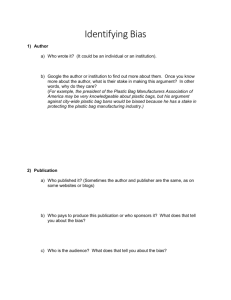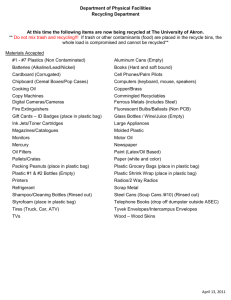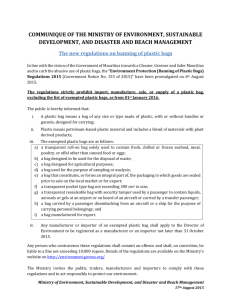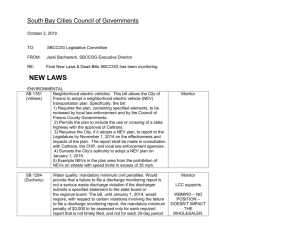POLYMER CAPT QUESTIONS
advertisement
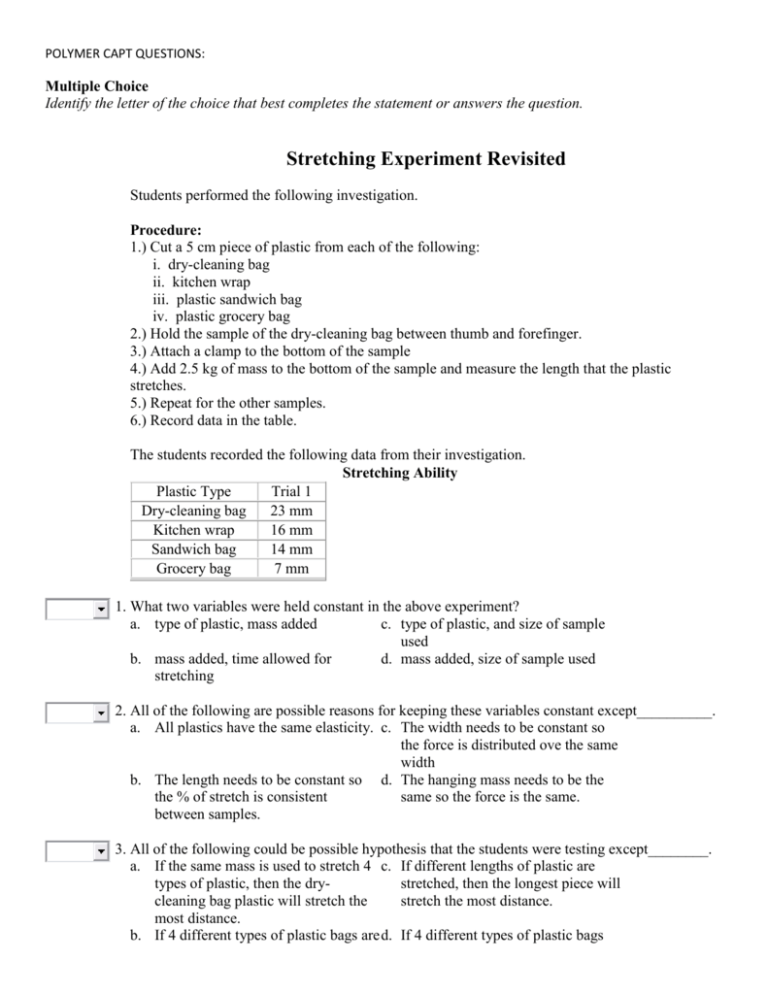
POLYMER CAPT QUESTIONS: Multiple Choice Identify the letter of the choice that best completes the statement or answers the question. Stretching Experiment Revisited Students performed the following investigation. Procedure: 1.) Cut a 5 cm piece of plastic from each of the following: i. dry-cleaning bag ii. kitchen wrap iii. plastic sandwich bag iv. plastic grocery bag 2.) Hold the sample of the dry-cleaning bag between thumb and forefinger. 3.) Attach a clamp to the bottom of the sample 4.) Add 2.5 kg of mass to the bottom of the sample and measure the length that the plastic stretches. 5.) Repeat for the other samples. 6.) Record data in the table. The students recorded the following data from their investigation. Stretching Ability Plastic Type Trial 1 Dry-cleaning bag 23 mm Kitchen wrap 16 mm Sandwich bag 14 mm Grocery bag 7 mm 1. What two variables were held constant in the above experiment? a. type of plastic, mass added c. type of plastic, and size of sample used b. mass added, time allowed for d. mass added, size of sample used stretching 2. All of the following are possible reasons for keeping these variables constant except__________. a. All plastics have the same elasticity. c. The width needs to be constant so the force is distributed ove the same width b. The length needs to be constant so d. The hanging mass needs to be the the % of stretch is consistent same so the force is the same. between samples. 3. All of the following could be possible hypothesis that the students were testing except________. a. If the same mass is used to stretch 4 c. If different lengths of plastic are types of plastic, then the drystretched, then the longest piece will cleaning bag plastic will stretch the stretch the most distance. most distance. b. If 4 different types of plastic bags are d. If 4 different types of plastic bags stretched, then dry-cleaning bag and kitchen wrap will stretch the most distance. are stretched, then the sandwich bag and the grocery bag will stretch the least amount of distance. How Tough is Tough? Students performed the following investigation. Procedure: 1.) Cut a piece of plastic from each of the following: i. dry-cleaning bag ii. kitchen wrap iii. plastic sandwich bag iv. plastic grocery bag 2.) Wrap 5 large ball bearings in the plastic and tie off with a rubber band. 3.) Drag the ball bearings/plastic across 10 cm of fine sand paper. 4.) Repeat dragging until a hole (at least 1 cm across) is formed. 5.) Record the number of passess required for the hole to form, in the data table. The students recorded the following data from their investigation: Plastic Type Dry-cleaning bag Kitchen bag Sandwich bag Grocery bag Toughness Number of passes to form hole 1 2 4 7 4. Which of the following is a valid conclusion based on the student’s data? a. The sanwich bag is the toughest of c. The grocery bag is the least tough of all the plastics tested all the plastics tested b. Kitchen wrap holds up better than all d. Plastic associated with food is the other plastics tested when tougher than the other plastics tested dragged across sandpaper that are associated with clothes 5. All of the following are ways that students could have improved on this experiment except_____. a. Students could have done multiple c. Students could have checked for trials and averaged the data holes every 5 cm of dragging distance b. Students could have used any holes d. Students could have specified the created in the plastic as indicators or size of the plastic piece they cut toughness
